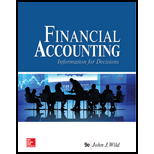
1.
Introduction: Accounts receivable are legitimately enforceable returns or payments which the organization will get from its clients who have bought its merchandise and services on credit. It is merely a promise to repay the vendor.
Bad debt is an amount that a company fails to receive when the debtors or become insolvent.
To prepare:
Bad debts are 1% of total revenue- Bad debts are 2% of accounts receivables.
2.
Introduction: Accounts receivable are legitimately enforceable returns or payments which the organization will get from its clients who have bought its merchandise and services on credit. It is merely a promise to repay the vendor.
Bad debt is an amount that a company fails to receive when the debtors or become insolvent.
To prepare: Adjusting entry for bad debts
3.
Introduction: Accounts receivable are legitimately enforceable returns or payments which the organization will get from its clients who have bought its merchandise and services on credit. It is merely a promise to repay the vendor.
Bad debt is an amount that a company fails to receive when the debtors or become insolvent.
To explain: If direct write off method is better or allowance method for computing bad debts is better.
Want to see the full answer?
Check out a sample textbook solution
Chapter 7 Solutions
Financial Accounting: Information for Decisions
- Subject:-- financial accounting questionsarrow_forwardCan you explain this financial accounting question using accurate calculation methods?arrow_forwardThe F Company sold the land for $86,000 in cash. The land was originally purchased for $56,000, and at the time of the sale, $17,000 was still owed to First National Bank on that purchase. After the sale, The F Company paid off the loan to First National Bank. What is the effect of the sale and the payoff of the loan on the accounting equation? 1. assets increase by $20,000; liabilities decrease by $15,000; owner's equity increases by $5,000. 2. assets increase by $60,000; liabilities decrease by $15,000; owner's equity increases by $20,000. 3. assets increase by $13,000; liabilities decrease by $17,000; owner's equity increases by $30,000. 4. assets increase by $20,000; liabilities decrease by $15,000; owner's equity increases by $35,000arrow_forward
 Intermediate Accounting: Reporting And AnalysisAccountingISBN:9781337788281Author:James M. Wahlen, Jefferson P. Jones, Donald PagachPublisher:Cengage LearningPrinciples of Accounting Volume 1AccountingISBN:9781947172685Author:OpenStaxPublisher:OpenStax College
Intermediate Accounting: Reporting And AnalysisAccountingISBN:9781337788281Author:James M. Wahlen, Jefferson P. Jones, Donald PagachPublisher:Cengage LearningPrinciples of Accounting Volume 1AccountingISBN:9781947172685Author:OpenStaxPublisher:OpenStax College

